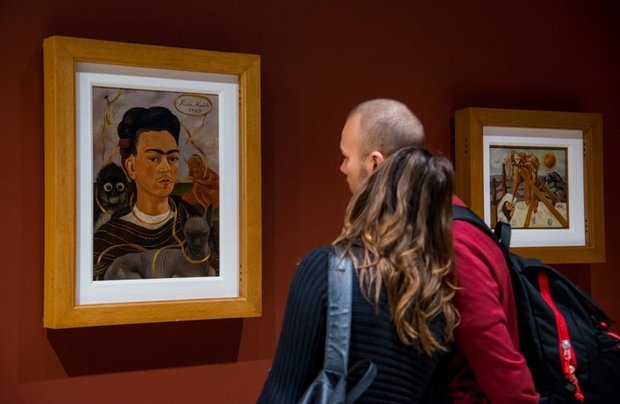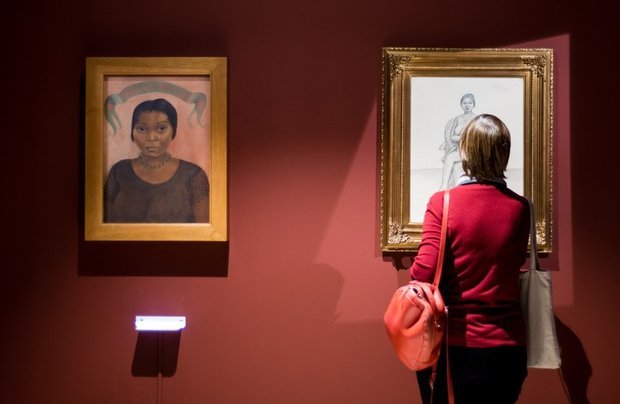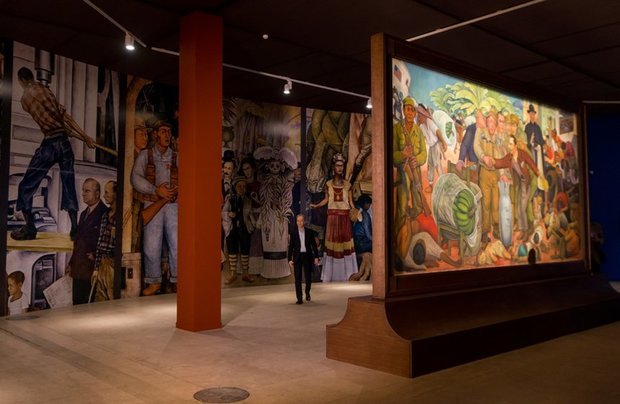Without public excitement: exhibition of Kahlo and Rivera in Moscow Manege
The fatal men and buses of Frida
A quite unusual situation: people are not lining up in a queue to see an exhibition of the two famous artists, to which, according to all estimates, it is quite difficult to make it. It is despite that the Moscow Manege is displaying the largest ever brought to the country collection of Frida Kahlo and Diego Rivera. The exhibition was visited by the correspondent of Realnoe Vremya.
Two colours
The first thing you pay attention to when approaching the Manege is the absence of a queue encircling the building. When a couple of years ago, the Faberge Museum in St. Petersburg held an exhibition of Frida Kahlo, and its collection in comparison with the one that is now brought to Moscow was less, in order to get into the hall it was necessary to stand in a queue for at least an hour and a half. In Moscow, there is nothing like this, and only a banner with a portrait of Frida on the facade of the exhibition hall reminds of the unique exhibition, which has been brought to Moscow by the same Faberge Museum. What's the reason? Is it a wrong marketing policy, minimum advertising? It may be.
In the halls, however, there are people, but they are not many. Of course, there is no such situation that once was in Vienna at the Bruegel exhibition, when one had to wait 15-20 minutes for the opportunity to approach the picture. You can safely take an audio guide at the box office and move freely from picture to picture.
When you get to the Manege, you immediately notice that the exposition is arranged perfectly. The first hall – biographies of artists, illustrated with archival photographs. The authors of the exhibition when painting the walls chose two different colours — the part that is dedicated to Frida, painted in terracotta, and the half dedicated to Diego — in blue. So it is in all the rooms.

The biography is noticeable even if you look at these carefully selected photographs. Frida with her father, wedding photo of Frida and Diego — she is a young beauty, he is plump, flabby, 20 years older. But – it was love. Frida and Trotsky, she had an affair with him in 1937, obviously Lev Davidovich conquered the Mexican woman with his charisma. When everything revealed, Trotsky had to leave the house of the artists. Unfaithfulness, divorce, returns — all this haunted the family life of Frida and Diego, but in the final both he and she said that they were the only for each other. Such thing also happens.
A Salvador Dali in a colourful skirt
Frida Kahlo created her art in the genre of naive art. And, my God, how her paintings differ from ''homegrown naivists''! The naive of Frida is in her pure, almost childish, view on life. The life that was cruel to her. A very young Frida had a serious accident. The bus she was on crashed into a tram. As a result — broken bones, injured spine, bedridden for some time, endless operations, pain and orthopedic corsets until the end of life. From which she made art objects with her own hands. And then the fatal bus appeared on her canvases.
As if struggling with pain and illness, she decorated the life around her. Her paintings are the celebration of bright palette, purity of colour. Her outfits, her flowers in her hair — like a challenge to a white hospital room. She was called ''a Salvador Dali in a colourful skirt'' — the colour was her ally in the fight against the disease.
She painted passionately, loved to paint portraits, she loved people. Paradox, but, perhaps, the absence of Frida's academic education made her style unique. Surrealism breaks through in some of her paintings with phantasmagorical images associated mainly with illness and death. ''I never paint dreams or nightmares. I paint my own reality,'' Frida Kahlo wrote. However, there is the age limit of 18+ for visiting the exhibition of Frida and Diego. And this is a reasonable restriction.

Frida was interested in the pre-Colombian art of Mexico and religious art, she tried to unravel the cultural and aesthetic codes leading to the ''space race'' of the Mexicans, of which she was a part. Her physical and moral suffering, in art it often happens, became the fertile ground on which her paintings grew.
Child prodigy
Diego Rivera was a child prodigy, he began painting at the age of 3, aged 11 he entered the Academy of Arts. So everything was ok with the academic art for him. Then he went to Europe, met with the Impressionists, made friends with Picasso, became interested in cubism. However, he was characterized by a mixture of artistic styles, as well as a mixture of political views — he was left, but could write to order for the capitalists.
Diego was a typical macho man – he broke a lot of women's hearts. The self-portrait, written in 1907 (this picture is on display), is psychologically accurate. He was whether Casanova, or the Mexican version of Russian Sergey Sergeyevich Paratov. In one word — fatal.
Once he even painted himself as a frog holding a woman's heart in his paws. But Frida Kahlo became for him, despite the constant betrayal, ''the eternal companion''. Most of the creativity Rivera gave to monumental painting — his monumental canvas ''Glorious Victory'' he gave the Soviet Union, where he repeatedly visited, the work is stored in the Pushkin Museum. By the way, in the fifties of the last century, a group of Mexican artists presented the USSR a large number of their works, but they were considered ''alien'' and were sent to the vaults. Among them there were the works of Frida and Diego.

Diego loved to paint ordinary people, loved to paint children, and their portraits were unusually warm. He wrote a lot to order, and with that money he collected a collection of pre-Colombian art — it was their common passion with Frida. By the way, he painted Frida in different styles, but always with love. Sometimes, though, it was love-hate – exactly like in Dostoevsky's books. However, the relationship between Frida and Diego was as if coming off the pages of a novel of the great Russian writer-psychologist.
The left-wing views of Rivera, and he was a member of the Communist party of Mexico, then came out of it, for some time most of his work was closed to Russian viewers, he was perceived in our country only as a Communist artist. At the exhibition in the Manege, fortunately, the ideology is not prominent. And Rivera here is different — tender, passionate, doubting.
After the exhibition, you can go to the stand with the double portrait of Frida and Diego and take a picture in their company. You can even rent a hair band, decorated with white and red flowers, which Frida so loved to wear, and take a picture in it.
The exhibition finishes with a large art shop where you can buy souvenirs. From books and albums to Mexican glasses. From colourful capes, raincoats, painted on the motives of the paintings of Frida, to traditional magnets and notepads. Or to buy a chocolate bar, the paper of which is also a reproduction of Frida's painting. And try the taste of her canvas.